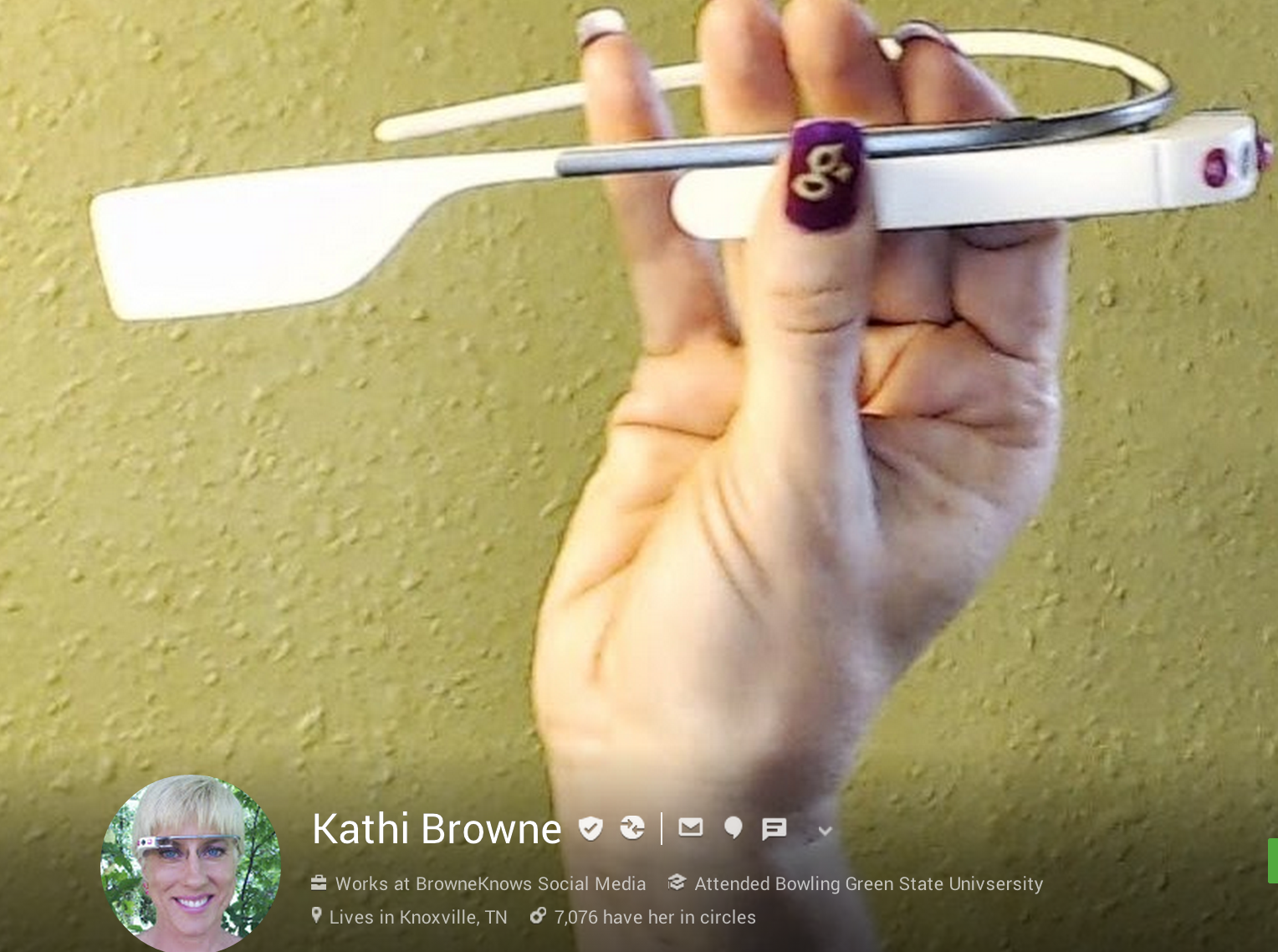Google Glass is in its infancy, with over 8000 “explorers” who are eager to find compelling uses for it. The concept is cool: A hands-free cell phone that is voice activated. A month ago my healthcare social media friend Kathi Browne, who is a Glass Explorer, proposed driving to Louisville from Knoxville to allow me to play with Glass for two days.
Google Glass is in its infancy, with over 8000 “explorers” who are eager to find compelling uses for it. The concept is cool: A hands-free cell phone that is voice activated. A month ago my healthcare social media friend Kathi Browne, who is a Glass Explorer, proposed driving to Louisville from Knoxville to allow me to play with Glass for two days.
 |
| Kathi Browne‘s Google+ site |
I was excited to accept her generous offer. She was equally accommodating about spending two days in my home which is presently a construction area with two cats, to which she is allergic. She seemed to tolerate the experience admirably.
As expected with a beta product, we had a few setbacks. We couldn’t tether Glass to my iPhone unless I gave up my grandfathered unlimited data plan. That wasn’t happening. Next we tried using the local network in my office. When that didn’t work we thought we’d found an answer jumping on my MiFi. That was great until Glass went into sleep mode (which is frequent due to a short battery life) which disrupted the MiFi connection and I couldn’t get it back online until the battery was taken out of the unit. It isn’t easy to remove. Finally Kathi just handed me her phone and I stayed live on her account.
The main advantage over a regular smartphone is how surprisingly unobtrusive the device is, both to you and the patients. It’s easy for the wearer to ignore it except when in use. Patients were of three varieties–too polite to ask what was on my head until I brought it up and then not caring, knowing immediately what it was and wanting to play with it, and being unaware of the product but excited to learn about it. No one appeared worried and the first thing I told them on entering the room was that it was not recording.
While it’s easy to understand how surgeons, teaching physicians or ER personnel might use Glass, its implications in the primary care office are less clear. A few thoughts:
- Glass is much less obtrusive than the laptop I carry or even the chart I used to carry. If I could dictate into the EHR this could enhance communication with patients.
- Having a projection screen that would show the patient what I was looking at could be used for education, the way I sometimes use my iPad now. For instance, I had a patient with shingles on her back and I could project her rash or a reference rash for comparison. I can do that with my iPad now but that involves carrying an iPad and a laptop. I don’t use the laptop for education because the screen is awful.
- On the down side, there is no unobtrusive way to Google a question using voice activation. My patients would know exactly how dumb I am. Wait, I already do that with them on the laptop so with Glass I could look cool and dumb.
- In a rural setting, sending a picture or a video from the exam room to a specialist would be advantageous but no more than telemedicine could do.
- Calling up an examination video for something I don’t do a lot of, like a specific orthopedic exam, could be helpful but I’m not sure about the patient’s reaction. They usually prefer to think their doctor is well-versed in such things. Back to cool and dumb.
- It’s quicker to Google with Glass, an advantage over a cell phone.
- The voice recognition is amazing. Odd names and medical terms were usually nailed on the first try. However, there didn’t seem to be a way to correct recognition mistakes.
- I suppose patients would get used to it, but would they worry that I was secretly recording them?
- As Clive Thompson commented in today’s New York Times[1], using Glass is uncomfortable enough that constantly looking at the little screen is not an option. That could improve communicating time instead of the way the EHR takes away from it.
- How about an app in Glass that would identify a rash within certain parameters of likelihood? That is, a Watson for Glass. This was also suggested by Melissa McCormack of Software Advice in the Profitable Practice blog.
1. Googling Yourself Takes on a Whole New Meaning http://goo.gl/WAAWki